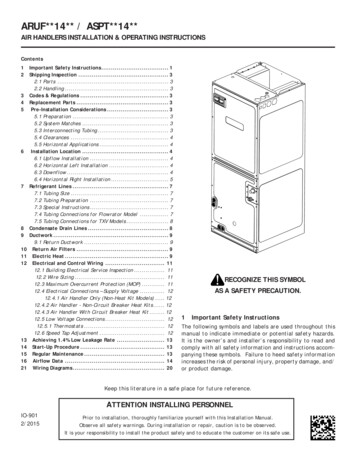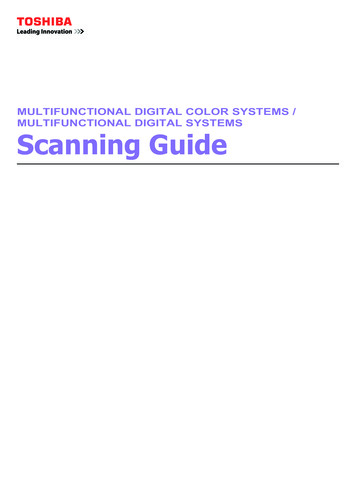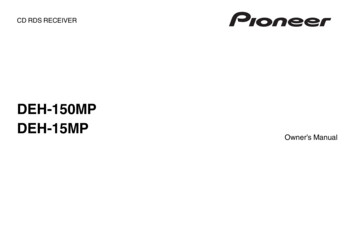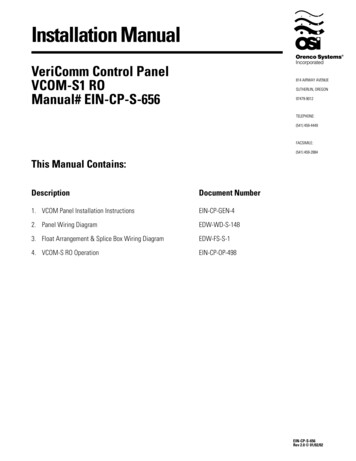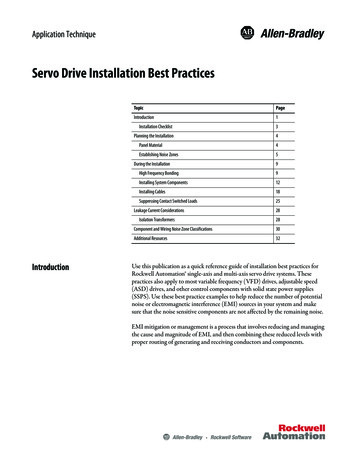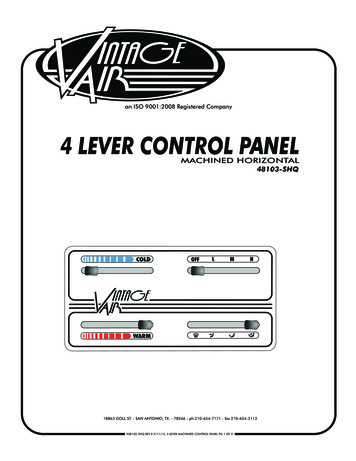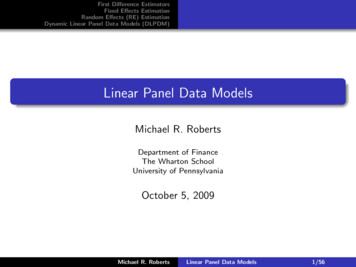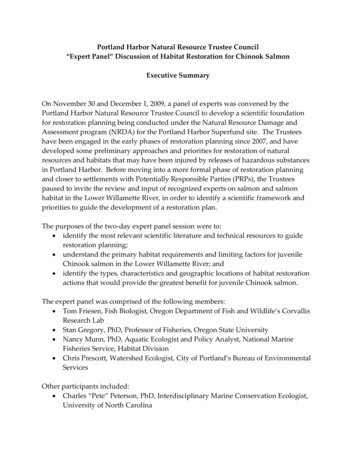
Transcription
Portland Harbor Natural Resource Trustee Council“Expert Panel” Discussion of Habitat Restoration for Chinook SalmonExecutive SummaryOn November 30 and December 1, 2009, a panel of experts was convened by thePortland Harbor Natural Resource Trustee Council to develop a scientific foundationfor restoration planning being conducted under the Natural Resource Damage andAssessment program (NRDA) for the Portland Harbor Superfund site. The Trusteeshave been engaged in the early phases of restoration planning since 2007, and havedeveloped some preliminary approaches and priorities for restoration of naturalresources and habitats that may have been injured by releases of hazardous substancesin Portland Harbor. Before moving into a more formal phase of restoration planningand closer to settlements with Potentially Responsible Parties (PRPs), the Trusteespaused to invite the review and input of recognized experts on salmon and salmonhabitat in the Lower Willamette River, in order to identify a scientific framework andpriorities to guide the development of a restoration plan.The purposes of the two‐day expert panel session were to: identify the most relevant scientific literature and technical resources to guiderestoration planning; understand the primary habitat requirements and limiting factors for juvenileChinook salmon in the Lower Willamette River; and identify the types, characteristics and geographic locations of habitat restorationactions that would provide the greatest benefit for juvenile Chinook salmon.The expert panel was comprised of the following members: Tom Friesen, Fish Biologist, Oregon Department of Fish and Wildlife’s CorvallisResearch Lab Stan Gregory, PhD, Professor of Fisheries, Oregon State University Nancy Munn, PhD, Aquatic Ecologist and Policy Analyst, National MarineFisheries Service, Habitat Division Chris Prescott, Watershed Ecologist, City of Portland’s Bureau of EnvironmentalServicesOther participants included: Charles “Pete” Peterson, PhD, Interdisciplinary Marine Conservation Ecologist,University of North Carolina
Erin Madden, Chair, Portland Harbor Natural Resource Trustee Council,representative of Nez Perce TribeRobert Wolotira, NOAA Restoration Center, Habitat Equivalency AnalystMegan Callahan Grant, NOAA Restoration Center, Restoration PlanningCoordinator for Portland Harbor Natural Resource Trustee Council (facilitator)Megan Hilgart, NOAA Restoration Center (recorder)Erin Madden provided an overview of the Portland Harbor Natural Resource TrusteeCouncil, its authorities under CERCLA and NRDA, and its phased plan for making thepublic whole for losses of natural resources, habitats and services in Portland Harbor.Nancy Munn presented background information on Endangered Species Act listings ofsalmonids that utilize habitat in the Harbor area, and factors that have been identifiedas limiting recovery of these species. Robert Wolotira provided an overview of HabitatEquivalency Analysis, using a Puget Sound site as an example. Tom Friesen describedthe findings of his research on juvenile Chinook diet and habitat utilization in theLower Willamette River. Stan Gregory and Chris Prescott provided relevantinformation on their biological and ecological research and monitoring of the Upperand Lower Willamette River.The expert panel reached consensus in the following areas:1.Juvenile Chinook salmon utilize the Lower Willamette River for feeding andrearing before entering the Columbia River Estuary to a greater extent thanpreviously believed. Chinook salmon are present almost year‐round in theLower Willamette.2. Both yearling and subyearling (young‐of‐the‐year) juvenile Chinook are found inthe Lower Willamette. Although migration rates for subyearlings have not beendirectly evaluated, studies have shown that Chinook migration rate increaseswith fish size. Therefore, subyearlings may spend more substantial amounts oftime than yearlings (more than two weeks) feeding and developing in the lowerWillamette.3. The area of the Lower Willamette that is most important for juvenile Chinookextends from Willamette Falls to the mouth of the Willamette (the broadestdefinition of the mouth or confluence with the Columbia includes the LowerColumbia mainstem from the Sandy River confluence upstream to the LewisRiver confluence downstream), including the confluence areas of the majortributaries (Clackamas, Johnson, Kellogg and Tryon creeks), and MultnomahChannel.
4. The most limited or scarce habitat types within this area include any refuge frommainstem Willamette flows (alcoves and off‐channel habitats, tributary mouths);shallow water and beach habitats with or without large wood assemblages; andundulating, natural shorelines. Other important potential limiting factorsinclude temperature and toxics, as well competition and predation by non‐nativespecies that are more tolerant of high temperatures and toxics.5. The extreme scarcity of key habitat types within the Portland Harbor study area(RM 1‐11.8) makes it the expert panel’s highest priority for restoration actions.Additional justification for this priority was provided by the panel The study area contains the most impaired habitat in the river; the river isalmost completely disconnected from its floodplain in this reach, with manyecosystem processes severely impaired. Further, physical alterations to thechannel’s edge severely limit availability of nearshore shallow water habitats. The Lower Willamette is the first (lowermost) major tributary junction in theColumbia River basin. A significant number of threatened and endangered (Columbia River andWillamette River) species use the area; all Willamette River stocks must passthrough the study area twice during their life cycle. The area’s history of toxic contamination poses growth and survivalchallenges for juvenile salmonids, reducing their resiliency to other stressors. The Lower Willamette contains the largest number of invasive/non‐nativespecies in the Willamette system, posing a further survival challenge to nativesalmonids. There is an important opportunity for public education and outreach in theurban area. Habitats within the study area are underserved by exsiting, non‐NRDAsources of funding for restoration, compared to the mainstem LowerColumbia River, and tributaries such as the Clackamas River.6. The expert panel developed a set of values for existing and potentially restorabletypes of habitat. The habitat types were evaluated based on their relativeimportance to juvenile Chinook, with the most important habitat types valued at1.0, and all other habitat types valued relative to those “ideal” habitat types.These values will be used by the Trustees to identify the current, as well aspotential future, value of specific habitats at specific locations as part of theHabitat Equivalency Analysis (HEA) model, and to calculate the increasedhabitat value or “lift” generated by restoration projects. The table of HEA valuesgenerated by the expert panel is attached to this summary.
7. The expert panel identified several characteristics that could increase the value ofa restoration project. These include: Restoration actions that would result in high quality habitat along both banksof a stretch of river Projects that provide off‐channel habitats or flow refuges at regular intervals(“stepping stones”), especially along the same side of the river Restoration actions that provide a connection to a cold water tributary Projects that provide cumulative ecosystem services (carbon sequestration,non‐structural flood storage, wetland, wildlife benefits) Projects of substantial size (expert panel noted that these are rare within thestudy area) so that ecosystem functions and processes are able to maintainhabitats with minimal human manipulation or maintenance Projects that restore multiple functional habitat types Projects that protect existing, high‐quality habitats Projects that reconnect portions of the historic flood plainRecommendations:The expert panel recommended a strong emphasis on restoration of habitats within thePortland Harbor study area, but also noted the importance of habitats upstream anddownstream of the study area. For upstream habitats (upstream of the study area toWillamette Falls), the panel recommended a focus on protecting intact habitats alongthe mainstem Willamette and tributary mouths that are currently developable and inprivate ownership. For downstream habitats (Multnomah Channel and WillametteRiver mouth and environs), the focus should be restoration of forested, complex andundulating shorelines, and the restoration of off‐channel habitats.Although the panel developed a table of initial relative values for each existing andpotentially restorable habitat type (for habitat equivalency analysis), the panel membersrecommended that the Trustees contract out for an independent literature review, andthat values be adjusted based on the results of that review.The panel suggested that Potentially Responsible Parties should be required to direct aminimum of one third to one half of their total liability to restoration projects inside thestudy area. The panelists identified conservation banking as one possible mechanism toensure timely and efficient implementation of high‐priority restoration actions. Thepanel also stressed the importance of long‐term monitoring, management andstewardship of restoration projects in order to ensure the highest possible degree of
scientific learning and the greatest chance of success, and encouraged the Trustees toaccount for these functions when estimating cost and value of restoration actions.
Table 1. Relative Chinook Salmon Lower Willamette Habitat ValuesHabitatHabitat CharacteristicsFunctionHab. ValYrs Until FullFunction5040 (80% in 10 yrs)5-40405--40** (80% in 10Uplandforested, in hist. floodplain, 200 ft from ACM*forested, outside historic floodplainvegetated, grass/shrub outside floodplainvegetated, invasive spp. outside floodplainforested along tributary into Willametteforested and part of the historic floodplainvegetated, grass/shrub in historic floodplainvegetated, invasive spp in historic 050.150.30.20.10Ripariannaturally vegetated forest, 200 ft from ACMand in the historic floodplainnaturally vegetated, grass/shruband associated with historic flood plaininvasive speciesSloped ( 5:1 or 11 ), unarmored andvegetatedSloped ( 5:1 or 11 ), unarmored andvegetatedsloped ( 5:1), unarmored and unvegetatedsloped ( 5:1), bio-engineeredsloped ( 5:1), bio-engineeredriprappedsheetpilepilings (1 per 100 sq ft)covered structures over channel marginsshallow water, gravel and finer substratesshallow water, natural rock outcropshallow water with riprap or concreteshallow water with covering structuresshallow water with pilings (1 per 100 sq ft)deep water with natural substratesdeep water with artificial substrates"Cold" water tributary"Warm" water tributaryside channelalcove or slough with tributaryalcove or slough without tributaryembayment (cove) with tributaryembayment (cove) without tributary0.50.650.20.350.1Active channelmarginMain ChannelOff Channel1yrs)5055330.230.830.430.230.110-half value of margin typemax of 0.1 --ACM Active Channel Margin**--this time adequate for juvenile chinook because of flood protection.***--around 0.6 further upstream
as limiting recovery of these species. Robert Wolotira provided an overview of Habitat Equivalency Analysis, using a Puget Sound site as an example. Tom Friesen described the findings of his research on juvenile Chinook diet and habitat utilization in the Lower Willamette River. Stan Gregory and Chris Prescott provided relevant


